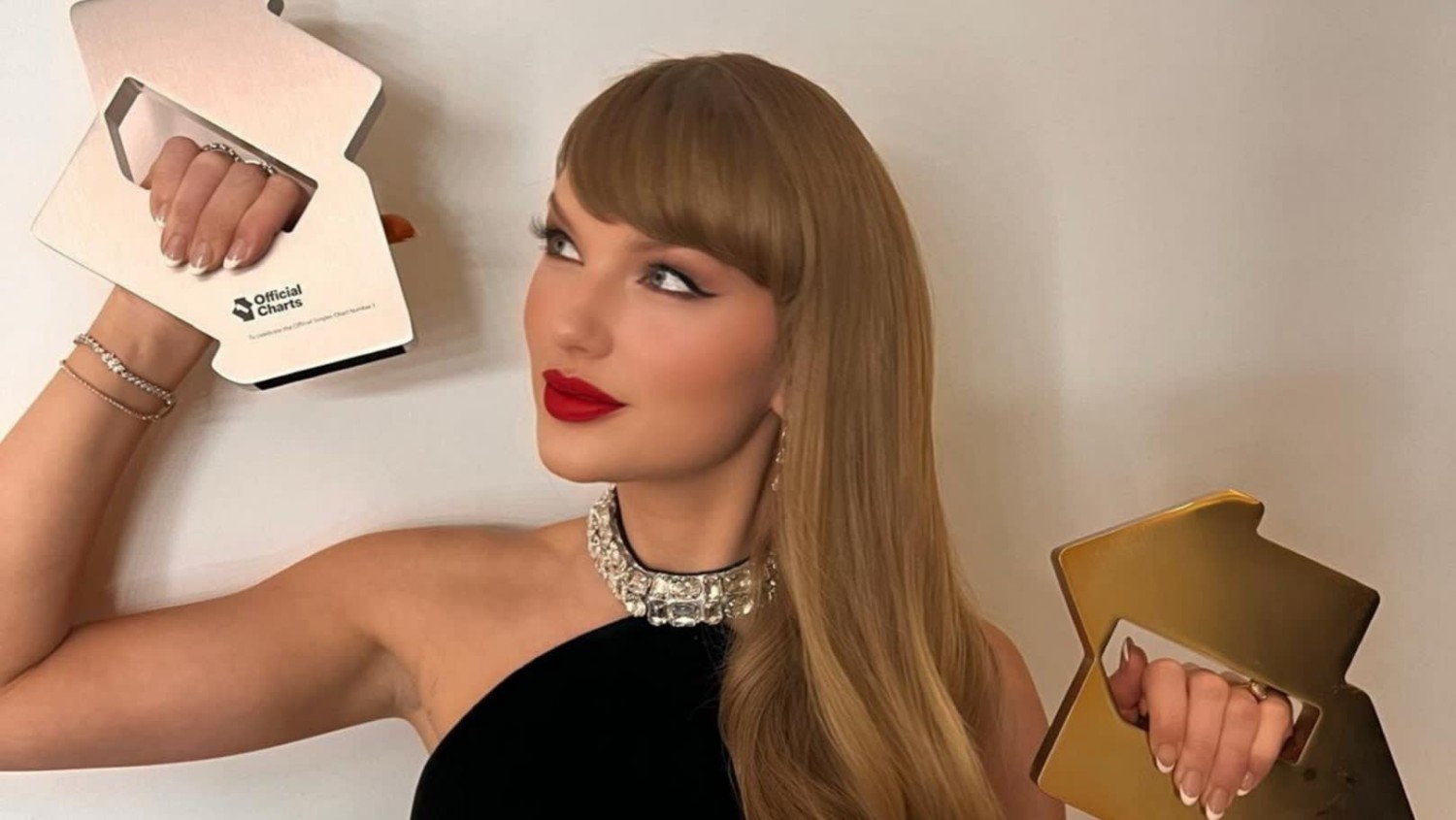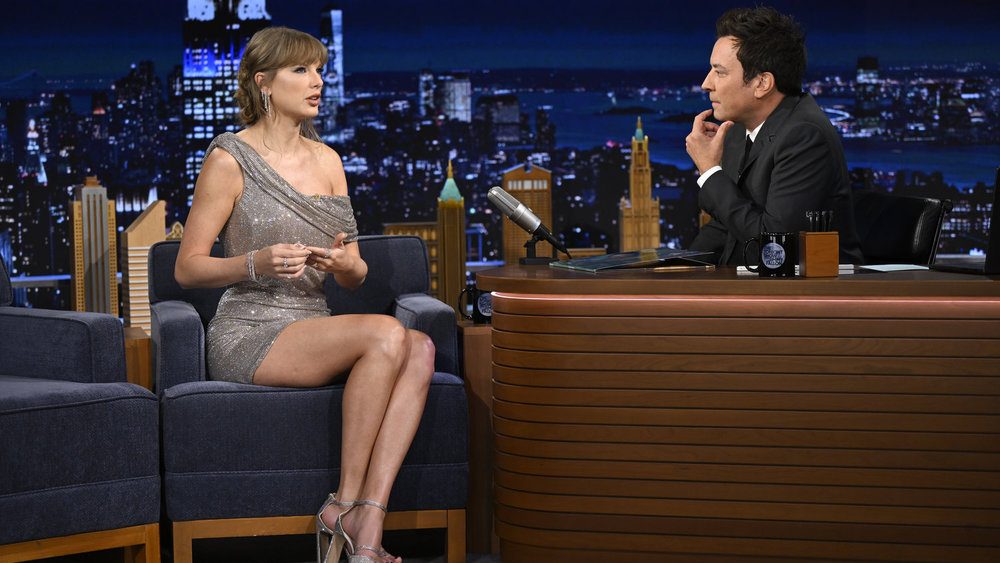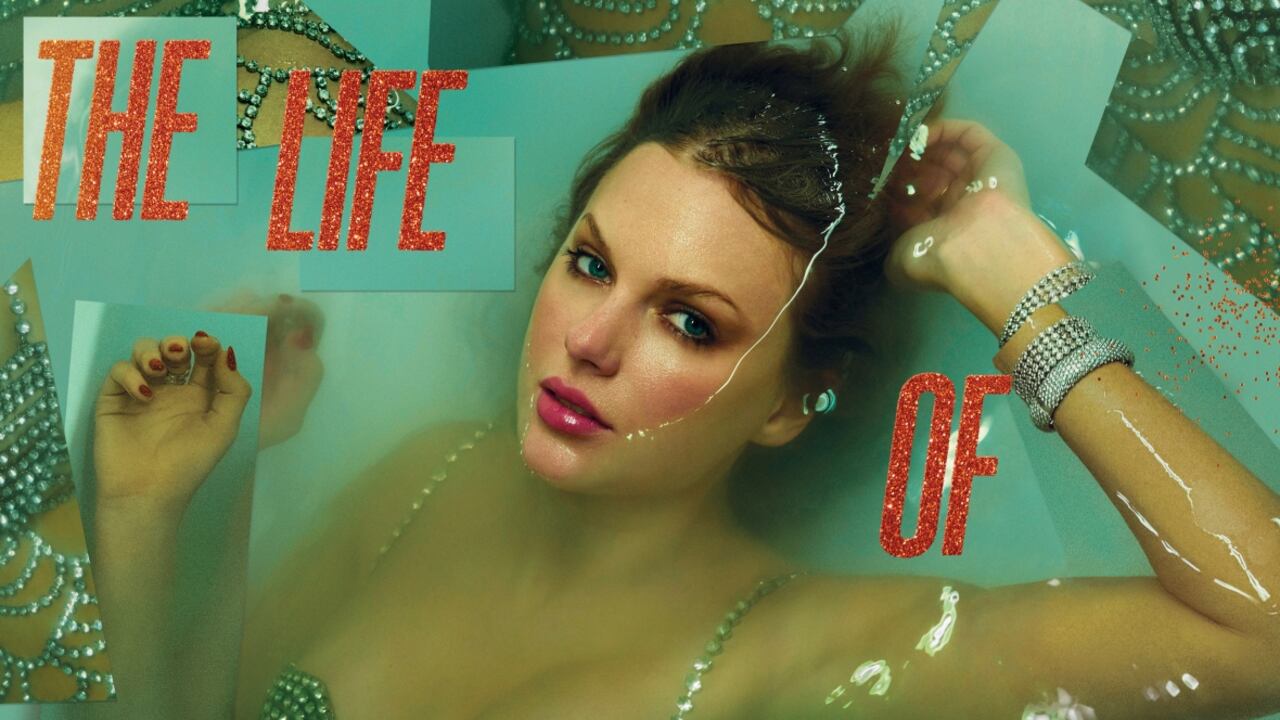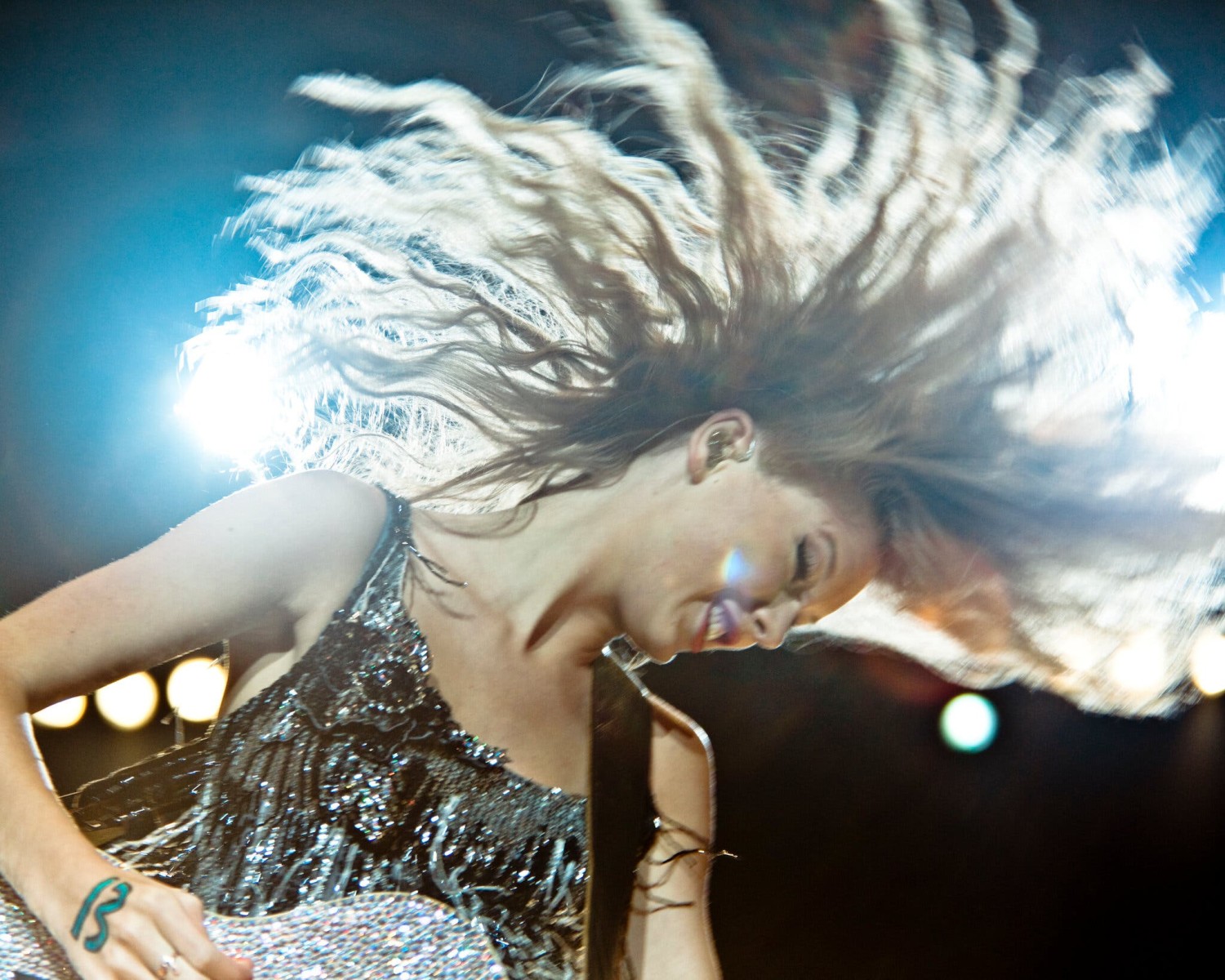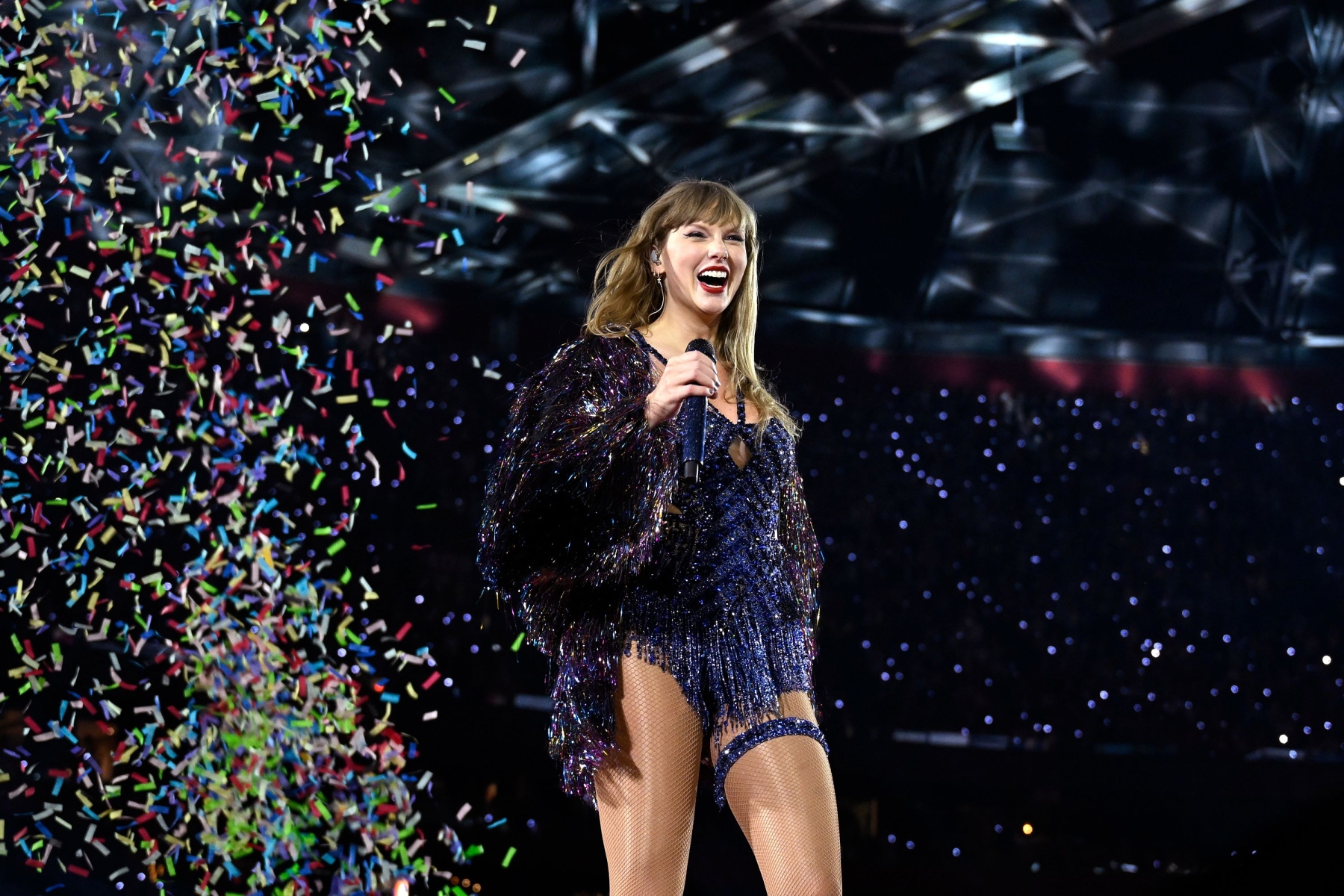
This article is more than
2 year old
Taylor Swift
6 min read
Taylor Swift Keeps Getting Swarmed. It’s Got To Stop
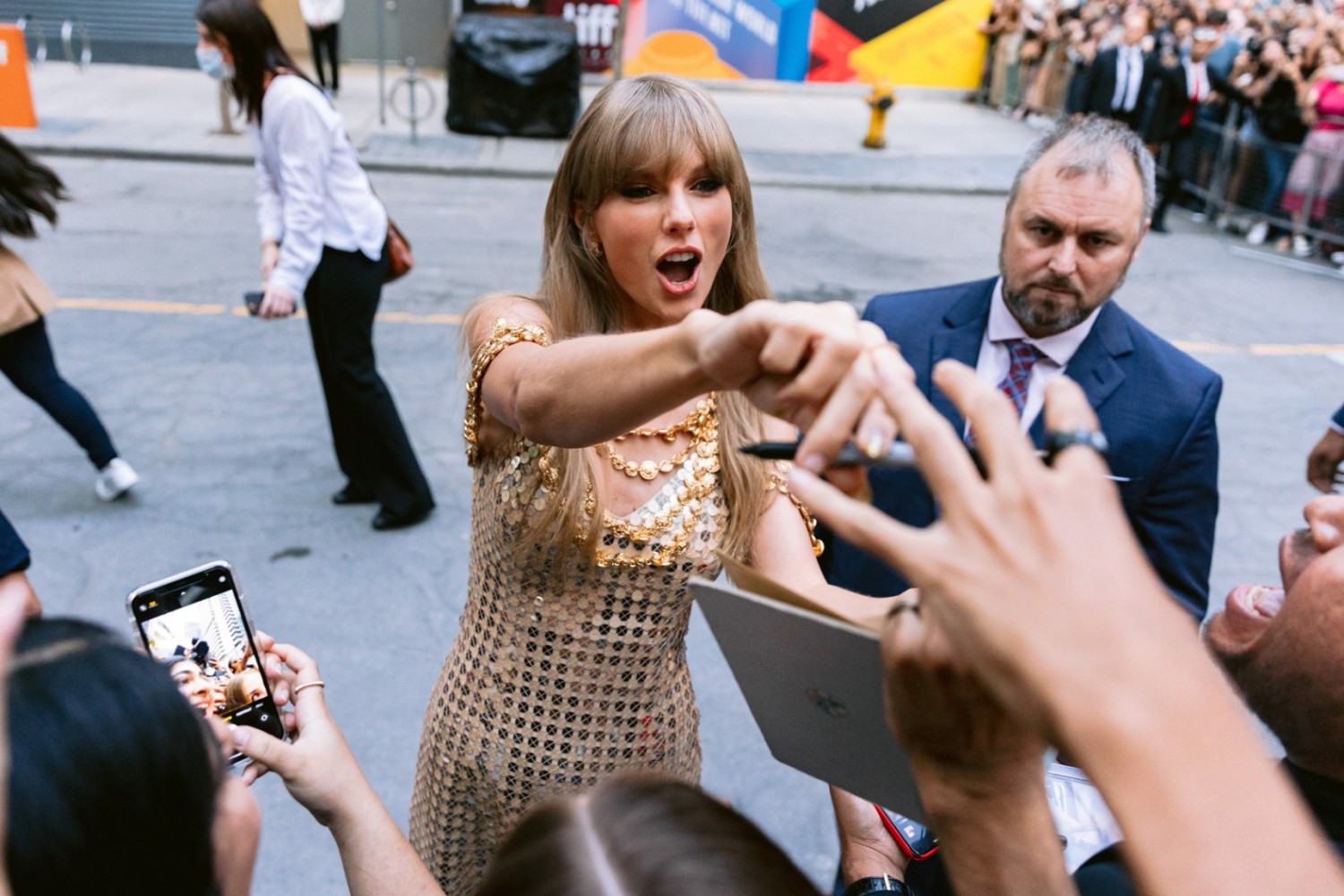
With Swift’s star power only getting bigger, her recent forays into the public are becoming a lesson on how fandoms should — and should not — behave
In the 2020 documentary Miss Americana, director Lana Wilson gave viewers unparalleled access to the behind-the-scenes life of beloved pop star Taylor Swift— with backstage views of her sold-out concerts, personal hideaways, crushing career disappointments, and first forays into major statements about politics. But what captured fans most online was a singular scene where Swift leaves her New York apartment to a ravenous, frenzied crowd outside her front door.
“So this is my front yard,” she says, eyes wide as she looks at the cheering crowd held back by security and a load of barricades. “And I’m highly aware of the fact that that is not normal.”
In the documentary, the crowds surrounding Swift are often used to juxtapose just how odd and solitary a life built on fame can be. But in the past year, as her successful Eras Tour and album re-recordings have sparked a wave of new Swift stans and reignited the already existing ones, this isn’t just a one-off scene in a film. It’s an everyday part of Taylor Swift’s life. Last week, during the New Jersey wedding of longtime collaborator and producer Jack Antonoff, massive crowds swarmed one of the wedding events to catch a glimpse of the pop star. Yes, that included paparazzi gathered to snap pics of the other famous partygoers. But viral videos from the day showed an overwhelming force of average people, swarming a street she was seen on, blocking traffic, entrances, and an entire intersection — all while chanting her name.
Famous artists have always inspired massive followings and crowds in public spaces. But what appears to be happening here is a rift between the Swift fandom of old and the deluge of “Swifties” that have grown with the singer’s massive popularity. Everyone loves Swift, so the old signifiers of fandom just don’t cut it anymore. And as the fandom grows larger, it’s not enough to buy each colored vinyl, or look for clues in her lyrics, or even bring friendship bracelets to the concerts. The next step is proximity, showing up to the concert even without a ticket, waiting hours outside a hotel she might be in, running after her town car when she leaves a recording studio, or — like last week — surrounding Swift in a small bar in New Jersey and making sure she knows how you feel about her. And while glimpses like this could make a Swiftie’s night, it’s clear that joy might be coming at the expense of the mental health and safety of people’s favorite star.
Let’s be real, it didn’t use to be this popular to like Taylor Swift. In fact, it’s easier to remember her album eras by her public perception at the time. During her debut album, she was criticized for being an unserious one-off, a critique young women musicians often receive. During Fearless and Red, she was called boy-crazy for writing songs about her exes, and even her successful transition from country to pop was eventually overshadowed by an incredibly public feud with Kanye West over his lyrics insinuating that he “made that bitch famous.” But following snubs by both the general public and the music community for her albums Reputation and Lover, Swift entered the 2020 pandemic. She came out of it as an artist who wrote like rent on all of her multi-million dollar homes was due. Now, firmly into the European leg of her groundbreaking Eras Tour, the critical and commercial success of three more studio albums, and her re-recordings, the Taylor Swift who graces the stage today has fans spanning generations and lifestyles. You and your besties are Swifties, your neighbor went to the Eras Tour and sat next to an Emmy-nominated actress, and even the mayors of several major metropolitan eras declared their cities Swifties for a day. Taylormania has gotten so intense it’s genuinely changed the economy, according to the Federal Reserve.
With the rise in popularity also comes a major shift in the way a star is received. This isn’t a new phenomenon on its own — as Elvis, The Beatles, and One Direction grew more popular, so did the response to seeing them in person. But the addition of social media and fan accounts has made the problem that much more inescapable. As an artist, Swift has spent years cultivating personal relationships with her fanbase, in the form of meet-and-greets, personalized deliveries, and intimate listening parties. For people who are part of the Swift “fandom,” it’s not just about playing her songs — it’s a community dedicated to every single aspect of Swift: her performances, her lyrics, her public reception, from the shoes she’s wearing to the people who have disrespected her. The Taylor Swift fandom isn’t a random group of people chatting — it’s its own tiny word. And the same specific, specialized interest that’s brought the Swiftie fandom together has also created agreed-upon insider language, rules, and codes. It’s coordination that has started massive fan projects at concerts, created intricate call and responses to Swift’s songs, and — prior to the pandemic — had an almost militant rule against swarming Swift in public.
But when a group of fans goes from a tight-knit community to a vague amalgamation of every person who’s ever heard and enjoyed a Swift song — things can (and have) gone haywire. Self-policing tools, like public callouts, or Reddit threads encouraging fans to give Swift privacy during trips, which might work on a group of a few hundred people, can’t control an entire New Jersey town. Because, when an artist gets this level of mainstream, the accepted rules of the fandom aren’t just inaccessible to a group of new fans. In some cases, the majority of casual fans don’t even know they exist.
Now instead of paparazzi at a grocery store, or a few hundred people shocked to see their favorite singer out and about, Swift must contend with fans live-tweeting her location to hundreds of thousands of people, while others spend endless hours camped out where she might be — even after she’s publicly stated dozens of times on how scared and uncomfortable it makes her. In her Folklore song “the lakes,” she even refers to intense crowds of gathered fans as “hunters with cellphones.”
If the past three years are any indication, Swift’s level of fame will only continue to rise. And despite intense public shaming that can occur online when Swift’s privacy is disrespected, it hasn’t stopped the gathered crowds from growing and growing and growing. But it’s clear that as these fan scenes get more and more chaotic, Swifties are hurtling towards a tipping point, one that might result in Swift’s appearances becoming fewer and farther between. In the title single for her album Midnights, Swift dissects her insecurities around fame and success in “Anti-Hero,” describing herself as a “monster on a hill,” who’s far too large to hang out. In fact, dozens of Swift’s most heartfelt songs, either about love or friendship, confess an intense desire to experience these things in private — and more intensely, the desire to run away from it all. For an artist who’s built her career on her genuine connection with fans and also her intense desire for just a shred of privacy, seeing Swift disappear from public life entirely would be an outcome unfair to an artist who has refused to put even the most disrespectful fans in their places. So Swifties, say it with me: Sometimes, it’s alright to stay home.
“So this is my front yard,” she says, eyes wide as she looks at the cheering crowd held back by security and a load of barricades. “And I’m highly aware of the fact that that is not normal.”
In the documentary, the crowds surrounding Swift are often used to juxtapose just how odd and solitary a life built on fame can be. But in the past year, as her successful Eras Tour and album re-recordings have sparked a wave of new Swift stans and reignited the already existing ones, this isn’t just a one-off scene in a film. It’s an everyday part of Taylor Swift’s life. Last week, during the New Jersey wedding of longtime collaborator and producer Jack Antonoff, massive crowds swarmed one of the wedding events to catch a glimpse of the pop star. Yes, that included paparazzi gathered to snap pics of the other famous partygoers. But viral videos from the day showed an overwhelming force of average people, swarming a street she was seen on, blocking traffic, entrances, and an entire intersection — all while chanting her name.
Famous artists have always inspired massive followings and crowds in public spaces. But what appears to be happening here is a rift between the Swift fandom of old and the deluge of “Swifties” that have grown with the singer’s massive popularity. Everyone loves Swift, so the old signifiers of fandom just don’t cut it anymore. And as the fandom grows larger, it’s not enough to buy each colored vinyl, or look for clues in her lyrics, or even bring friendship bracelets to the concerts. The next step is proximity, showing up to the concert even without a ticket, waiting hours outside a hotel she might be in, running after her town car when she leaves a recording studio, or — like last week — surrounding Swift in a small bar in New Jersey and making sure she knows how you feel about her. And while glimpses like this could make a Swiftie’s night, it’s clear that joy might be coming at the expense of the mental health and safety of people’s favorite star.
Let’s be real, it didn’t use to be this popular to like Taylor Swift. In fact, it’s easier to remember her album eras by her public perception at the time. During her debut album, she was criticized for being an unserious one-off, a critique young women musicians often receive. During Fearless and Red, she was called boy-crazy for writing songs about her exes, and even her successful transition from country to pop was eventually overshadowed by an incredibly public feud with Kanye West over his lyrics insinuating that he “made that bitch famous.” But following snubs by both the general public and the music community for her albums Reputation and Lover, Swift entered the 2020 pandemic. She came out of it as an artist who wrote like rent on all of her multi-million dollar homes was due. Now, firmly into the European leg of her groundbreaking Eras Tour, the critical and commercial success of three more studio albums, and her re-recordings, the Taylor Swift who graces the stage today has fans spanning generations and lifestyles. You and your besties are Swifties, your neighbor went to the Eras Tour and sat next to an Emmy-nominated actress, and even the mayors of several major metropolitan eras declared their cities Swifties for a day. Taylormania has gotten so intense it’s genuinely changed the economy, according to the Federal Reserve.
With the rise in popularity also comes a major shift in the way a star is received. This isn’t a new phenomenon on its own — as Elvis, The Beatles, and One Direction grew more popular, so did the response to seeing them in person. But the addition of social media and fan accounts has made the problem that much more inescapable. As an artist, Swift has spent years cultivating personal relationships with her fanbase, in the form of meet-and-greets, personalized deliveries, and intimate listening parties. For people who are part of the Swift “fandom,” it’s not just about playing her songs — it’s a community dedicated to every single aspect of Swift: her performances, her lyrics, her public reception, from the shoes she’s wearing to the people who have disrespected her. The Taylor Swift fandom isn’t a random group of people chatting — it’s its own tiny word. And the same specific, specialized interest that’s brought the Swiftie fandom together has also created agreed-upon insider language, rules, and codes. It’s coordination that has started massive fan projects at concerts, created intricate call and responses to Swift’s songs, and — prior to the pandemic — had an almost militant rule against swarming Swift in public.
But when a group of fans goes from a tight-knit community to a vague amalgamation of every person who’s ever heard and enjoyed a Swift song — things can (and have) gone haywire. Self-policing tools, like public callouts, or Reddit threads encouraging fans to give Swift privacy during trips, which might work on a group of a few hundred people, can’t control an entire New Jersey town. Because, when an artist gets this level of mainstream, the accepted rules of the fandom aren’t just inaccessible to a group of new fans. In some cases, the majority of casual fans don’t even know they exist.
Now instead of paparazzi at a grocery store, or a few hundred people shocked to see their favorite singer out and about, Swift must contend with fans live-tweeting her location to hundreds of thousands of people, while others spend endless hours camped out where she might be — even after she’s publicly stated dozens of times on how scared and uncomfortable it makes her. In her Folklore song “the lakes,” she even refers to intense crowds of gathered fans as “hunters with cellphones.”
If the past three years are any indication, Swift’s level of fame will only continue to rise. And despite intense public shaming that can occur online when Swift’s privacy is disrespected, it hasn’t stopped the gathered crowds from growing and growing and growing. But it’s clear that as these fan scenes get more and more chaotic, Swifties are hurtling towards a tipping point, one that might result in Swift’s appearances becoming fewer and farther between. In the title single for her album Midnights, Swift dissects her insecurities around fame and success in “Anti-Hero,” describing herself as a “monster on a hill,” who’s far too large to hang out. In fact, dozens of Swift’s most heartfelt songs, either about love or friendship, confess an intense desire to experience these things in private — and more intensely, the desire to run away from it all. For an artist who’s built her career on her genuine connection with fans and also her intense desire for just a shred of privacy, seeing Swift disappear from public life entirely would be an outcome unfair to an artist who has refused to put even the most disrespectful fans in their places. So Swifties, say it with me: Sometimes, it’s alright to stay home.
To Read the Full Story
SUBSCRIBE NOWFollow
Advertisement
